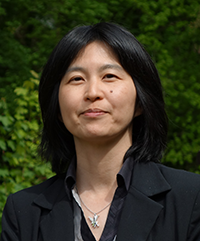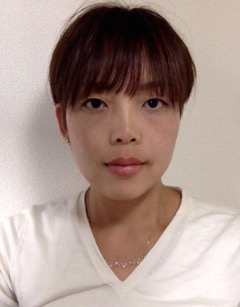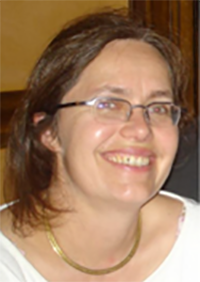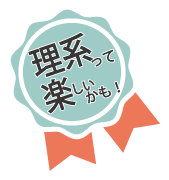レクチャー概要
御手洗容子 Yoko MITARAI
 自己紹介
自己紹介
 東京工業大学の金属工学科に入学し、そこで博士課程まで修了し、博士(工学)号を取得しました。大学では、耐熱金属材料として当時注目されていたTiAlの相変態の研究を行いました。博士号を取得した後、日本学術振興会の研究生となり、イギリスのマンチェスター大学に8か月滞在してTiAlの研究を続けました。その後、金属材料技術研究所(現在の物質・材料研究機構)に就職し、耐熱材料の研究室に所属して、イリジウムという金属を使った超高温材料(1800℃で使用)の研究を行いました。現在は、高温で作動する形状記憶合金や、耐熱Ti合金の研究を行い、飛行機のジェットエンジンや火力発電所などの高温機器の燃焼効率を上げる材料の開発を目指しています。
東京工業大学の金属工学科に入学し、そこで博士課程まで修了し、博士(工学)号を取得しました。大学では、耐熱金属材料として当時注目されていたTiAlの相変態の研究を行いました。博士号を取得した後、日本学術振興会の研究生となり、イギリスのマンチェスター大学に8か月滞在してTiAlの研究を続けました。その後、金属材料技術研究所(現在の物質・材料研究機構)に就職し、耐熱材料の研究室に所属して、イリジウムという金属を使った超高温材料(1800℃で使用)の研究を行いました。現在は、高温で作動する形状記憶合金や、耐熱Ti合金の研究を行い、飛行機のジェットエンジンや火力発電所などの高温機器の燃焼効率を上げる材料の開発を目指しています。
2006年からグループリーダー、2011年からワルシャワ工科大学の客員教授、2014年から構造材料研究拠点の副拠点長、2015年から芝浦工大客員教授として、研究マネージメントも行っています。2014年10月からSIP革新的構造材料「革新的プロセスを用いた航空機エンジン用耐熱材料創製技術開発」という国家プロジェクトのプロジェクトリーダーをしています。2016年1月には湯浅年子賞をいただきました。
 講義内容
講義内容
金属材料は身の回りの様々なところに使われています。その中でも私が興味を持っているのは高温で使われる金属材料です。室温では強靭な金属材料も温度が高くなるにつれ、変形しやすくなり、大きな力に耐えられなくなります。また、酸素がある雰囲気で使われると、表面で酸素と金属が反応して「酸化」という現象が起こります。高温で使われる金属材料は、これらの欠点を克服して、高温でいかに大きな力に耐え、酸化を少なくするかが重要です。この講義では、ジェットエンジンや火力発電所で使われている耐熱鋼、Ni基超合金、Ti合金などの金属材料をいくつか紹介し、高温で使うために、どのような材料設計をしているかの紹介をします。また、大きなプロジェクトを進めていく時の、大変さと面白さについても紹介します。
苔山圭以子 Keiko KOKEYAMA
 自己紹介
自己紹介

お茶の水女子大学博士後期課程課程修了後、ポスドク研究員としてイギリスのバーミンガム大学で欧州の次世代重力波プロジェクトの基礎研究を行いました。その後、米国の重力波検出器プロジェクト Advanced LIGO に参加しました。当時、ちょうどインフラの整備が終わり、検出器のさまざまなパーツがインストールされている時期で、いよいよ検出器のコミッショニングが始まろうとしていた時期でした。私は、2台あるLIGO検出器のうちのひとつ、ルイジアナ州のリビングストン観測所にて、Advanced LIGO 検出器を安定に稼働させるためのさまざまな研究を行いました。LIGOでの研究は大変なことも多かったですが、とても勉強になりました。私は現在は、日本の重力波検出器プロジェクトであるKAGRAの稼働を目指し、日々地下トンネルに潜りいろいろな実験や調整を行っています。
 講義内容
講義内容
LIGOでは2015年9月にとうとう重力波が初検出されました。重力波は時空のゆがみが波として伝わる現象で、アインシュタインが100年前に予言していました。1960年ごろから検出器の開発が始まりましたが、重力波の効果はものすごく小さいため、技術的な困難も多く、なかなか検出することができませんでした。とうとう初検出された信号は、多くの科学者の予想をとは違い、ブラックホール連星合体からのものでした。重力波による空間のゆがみがはじめて検出できただけでなく、これまでの望遠鏡では見ることができなかった天体現象を観測するという大発見となりました。講義では、今回の発見の意義、検出のしくみ、重力波天文学などについて説明します。また、日本のプロジェクトについても紹介します。
Marie Emmanuelle Couprie
 Profile
Profile

Marie-Emmanuelle Couprie graduated from École Normale Supérieure de Jeunes Filles, shed received her PhD in 1989 on storage ring Free Electron Lasers, and Habilitation to Direct Research in 1977 at Orsay University. She has more than 25 years of experience in synchrotron radiation and Free Electron Laser (FEL), where intense radiation is generated on particle accelerators. She worked in LURE (Laboratoire d’Utilisation du Rayonnement Electromagnétique in Commissariat à l’Énergie Atomique) on the ACO storage ring FELs, ACO (France), the second worldwide FEL, on Super-ACO where she launched the first FEL applications in UV and two-colour applications with VUV synchrotron radiation, and under collaborations (VEPP3 (Russia) for FEL linewidth narrowing, ELETTRA (Italy), UVSOR (Japan)). Then, she moved to FEL on linear accelerators, led the ARC-EN-CIEL project and collaborated with SCSS Test Accelerator in Japan, SPARC in Italy for first seeding with high order harmonics in gas. She is at Synchrotron SOLEIL since 2006 as head of the Magnetism and Insertion device group, where she also leads the LUNEX5 project of compact advanced FEL in France, with several R&D programs (for example, the European Research Council Advanced Grant COXINEL that she obtained for demonstration of FEL amplification with laser plasma accelerated electrons, a cryogenic undulator, FEL shaping studies..). She is a member of the French Physical Society, and of the Accelerator Group of European Physical Society. She received different awards (Aumale Prize (French Academy of Science (1993)), prize of the Interdivision of Accelerator and Associated Technologies / French Physical Society (2001), International FEL prize (2001), Chevalier of the order of Academic Palms (2002)). She supervised 12 PhD students.
M.E. Couprie さんは自由電子レーザー(Free electron laser, FEL)を生成する加速器の研究者です。
位相の揃った指向性の高い光であるレーザーは、固体やガスなどの媒体で発振する波長が決まっています。
一方で、FELは、周期的な磁場中で電子を蛇行させて、強い光を狭い範囲に集中して放射させる光源であり、
波長を比較的自由に選ぶことができます。またX線という非常に波長の短い光を発振することができるため、
物質の極めて細かい構造の解析などの最先端の研究に使われています。
レーザーを出す電子はエネルギーが高く、加速器という大きな装置が必要です。M.E.Couprieさんは、25年以上にわたってFELと加速器の研究に携わってきた専門家で、日本のUVSORを始め、各国の加速器施設と共同研究をされてきました。近年は、大型加速器に代わる手法としてレーザープラズマと組み合わせた高性能小型FELの研究の第一人者としても活躍しています。
 Abstract
Abstract
With the dream to do research, i.e. to participate to the quest of knowledge and I had the chance to enter Ecole Normale Supérieure de Jeunes Filles. This specific French Institute of higher education (1881-1985) for women was created in 1881 after opening high school (Lycée) to girls, to educate them for becoming teachers. In 1987, it was stated that it should deliver a high level cultural and scientific education to women for them to become teachers in high school and university, researchers and more generally serve in the high level administration and companies. In such an environment, it was natural to envision a scientific career with the present and former examples of teacher, such as Marie-Curie.
My present field of research is the generation of light using particle accelerator, which are called light sources. On third generation one where I work now at SOLEIL, radiation is produced from the infra-red to the X-ray, for the investigation of matter. On fourth generation light sources, we even generate a very intense laser light, which can cover a broad spectral range (from infra-red to X-ray). The advent of these specific lasers is a king of second revolution after the laser invention in 1960, since it enables to investigate dynamical processes (in doing molecular movies).
This scientific work in fact presents many aspects. There is a large variety of work, from managing a big project to dealing with equation and fundamental processes. Wonder and great pleasure arise from the beauty of physics in front the simplicity of a model explaining some phenomenon, or ideas leading to new devices; and more generally from the creativity process. Training, educating students and transmitting knowledge are also essential. Research is as welle an opening to the world, with its international community.


